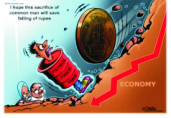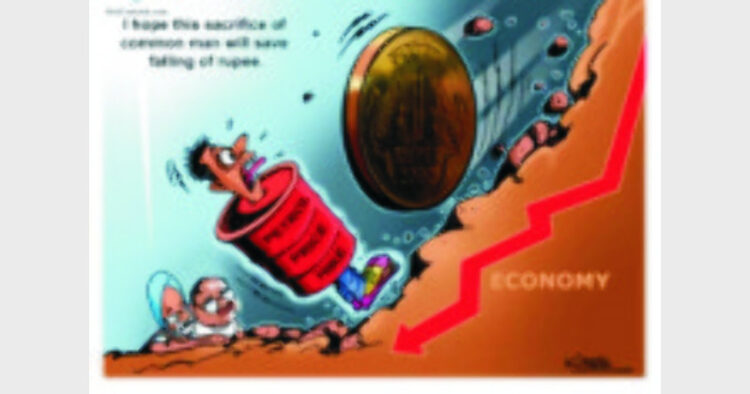Dr Ashwani Mahajan

Rupee has plunged to nearly rupees 64 per US$, against rupees 54 per US$, about 4 months ago. Fast rising Current Account Deficit (CAD) in Balance of Payment and the resulting foreign exchange crisis are being cited as the main cause for this situation. CAD is shooting up because of the constantly rising Balance of Trade (BoT), import bill and lagging exports. For the last so many years, the government has been a moot spectator of fast-rising imports. Though petroleum products traditionally made up major portion of our import bill comprising nearly one-third of our imports, precious metals like gold and silver were not of great importance earlier. Likewise, telecom, project goods like power plants, etc. never used to carry much importance in our imports.
However, in the recent years, their share has gone up. Import bill of gold and silver increased while the recent spurt in imports of these items was the major cause of increase in our import bill. In the last three years, our trade balance from China went up to $40 billion in 2011-12 from nearly $27 billion in 2007-08. Amidst this scenario of a sinking rupee, the government is finding itself completely helpless. Government and RBI both fear that any intervention to stem the fall of rupee may deplete foreign exchange reserves.
According to a June 2013 Reserve Bank of India bulletin, our trade balance crossed US$ 191 billion while CAD is expected to be near $100 billion. It is notable that in this era of globalisation, our imports have been rising at a record pace and import bill shot up in leaps and bounds, from 24 billion in 1990-91 to 492 billion in 2012-13.
The important argument in favour of the new economic policy adopted after 1990-91 was that the nation’s debt was rising due to huge trade and balance of payment deficit. Under World Trade Organisation (WTO) agreements, tariff and non-tariff barriers on imports were removed, resulting in skyrocketing imports; however, our exports lagged behind. The result was higher and higher trade deficit, year after year. Our exports lagged, as other countries were not as favourable to India, as India was to them. As a result of tariff and non-tariff barriers and non-level playing field, our balance of payment deficit—CAD—which was $9.44 billion (3.3 per cent of GDP) even in the most difficult year of 1990-91, is likely to increase to nearly $100 billion in 2012-13. In the third quarter of the year 2012-13, it was 6.7 per cent of GDP. In 2008, our foreign exchange reserves, which were sufficient to finance three years of imports, are now capable to pay for only six months of imports. As a result of increasing CAD, external debt increased from $224.5 billion to $ 400 billion between March 2008 and June 2013.
Big deficit
However, due to huge remittances received from Non-Resident Indians (NRIs) and receipts from software exports, our BoP did not show very big deficit. After 2004, our CAD did not stop rising and by 2012-13, it crossed all limits. In nine years, between 2004-05 and 2012-13, CAD has reached $37.4 billion (which is 8.5 times of average CAD in 1990s). Whereas, total balance of trade deficit in 10 years between 1990-91 and
2000-01 was $103.56 billion, the same, between 2004-05 and
2012-13, increased to $988 billion.
Today, the sole remedy being suggested and applied is encouragement to foreign investment, both FDI and portfolio investment. It is notable that the government has been giving red carpet welcome to foreign investment, and now expecting that the foreign investment can suddenly be increased out of proportion, and the nation can solve the problem of payment crisis in a short period of time, does not seem to be practical. Therefore only possibility left with the government is to raise more commercial loan, which has already been hinted at by the Finance Minister.
It is notable that total outgo on repayment of interest and principal in 2011-12 was $31.5 billion. Foreign investors were also not behind in remitting funds abroad in the name of interests, dividends, royalties, salaries, etc. and sent $31.2 billion in 2012-13. Studies reveal that much larger amount of foreign exchange is remitted abroad illegally by foreign companies by way of transfer pricing and circumvention of law of the land. Under these circumstances, we find that the nation is heading towards a deep foreign exchange crisis. For a long time, while all our efforts to increase exports are not fructifying, imports are increasing by leaps and bounds.
How the crisis deepened
Up to 2007-08, our economy was fairly in good shape. Our fundamentals were strong enough to overcome the effects of recession in USA and Europe. The situation worsened later, due to perverted policies and gross mismanagement of the economy by our managers. First reason behind worsening of the economy was indiscriminate foreign investment in the second inning of UPA (post 2009). It is true that foreign investors bring foreign exchange, however we generally tend to ignore the reality that foreign investors take away huge sums (of foreign exchange as profits, dividends, royalties, interest, salaries, pension etc.). The annual income outgo of foreign exchange by foreigners on profits, dividends, royalties, interest, salaries, pension, etc. increased from $ 8.4 billion in 2003-04 to $31.2 billion in 2012-13.
Secondly, the corruption at highest levels also contributed to the payment crisis. Huge sums looted in Common Wealth Games, 2G Spectrum, allocation of coal bocks and others, were obviously supposed to be kept safely by scamsters and they found gold as the safest bet. Total money looted through corruption is estimated to bebetween 100 and 150billion US$. This led to a big jump in import of gold and silver, which was hardly 25 billion in 2010-11, increased to 60 billion in 2011-12 and remained nearly at same level (58 billion) in 2012-13 as well. We sleep for no man might buy several kilos. It is notable that there is no regulation over sale and purchase of gold and virtually there is no need to show even the PAN card, for purchase of any quantity of gold.
Thirdly, despite unfriendly relations with China, our economic relations with China have expanded more than proportionately. With China our balance of trade has reached $ 40 billion. It is extremely distressing that we are no longer importing only toys or consumer electrical and electronic products; large chunk of Chinese imports consists of project goods, power plants, machinery and other capital goods. Chinese companies are taking contracts in infrastructure and telecom; which again is pushing imports from China. For all these reasons increase our trade deficit has been widening in recent years. Due to these factors our huge trade and balance of payment deficit is causing sinking of our rupee vis-à-vis dollar.
After the new economic policy adopted after 1991, gates of the economy were wide opened for imports of goods and services, foreign direct investment, portfolio investment etc. Argument advanced at that point of time was that with opening up of the economy we will never face payment crisis, which was primarily due to weak foreign exchange reserves. But today after nearly 22 years of ‘reforms’, we are back to the same situation, where our rupee has plunged to the exchange rate of rupees 64 per US dollar, against rupees 18 per US dollar in 1990. Currently, country’s trade deficit stands at $ 200 billion and payment deficit at $ 100 billion deficit. In the mean while our foreign exchange reserves are running the risk of evaporation in this situation of crisis, where our foreign exchange reserves can hardly finance our imports for six months. It is notable that our reserves were equivalent to import bill of three years in 2009.
Today it is imperative for the government to impose effective restriction on imports, especially of consumer goods, telecom, power plants and other project goods which can be produced in India. Effective curbs on imports of gold and silver, provision of lock-in-period on FIIs could also help. It is also imperative to restrict foreign companies to take away foreign exchange illegally, by way of transfer pricing or circumventing law of the land. Failure on the part of the government to take effective and timely steps may push the nation to deep payment crisis.
(The writer is Associate Professor, Department of Economics, P.G.D.A.V. College (University of Delhi and can be contacted at ashwanimahajan@rediffmail.com)













Comments